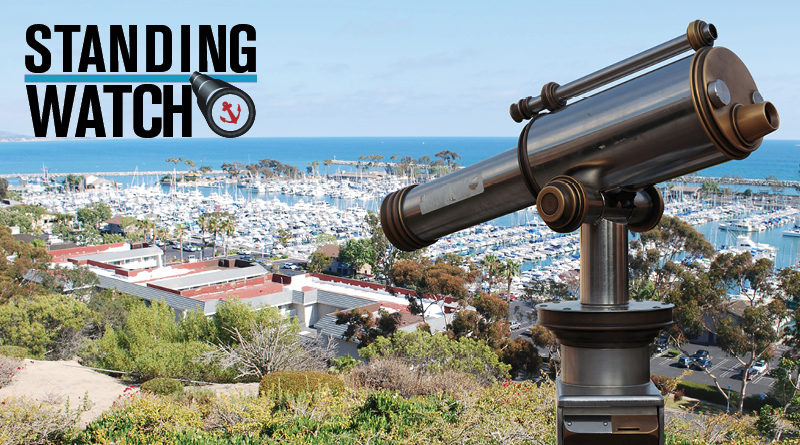Cruising to Mexico: Should you heed the warnings?
Travel advisories are often issued by the United States, but how dangerous is it south of the border?
MEXICO — The Log’s next issue (Oct. 5-18) will delve into the many activities available to boaters in Mexico. There are certainly a fair share of boaters who navigate to and from Mexico’s many marinas and boating destinations on a regular basis, giving no mind to the travel advisories issued by the U.S.’s State Department. Yet others might buy into this notion of Mexico being a drug cartel playground, with innocent U.S. tourists caught in the middle of heated gun battles.
Traveling always comes with risks, to be sure. Some people will invariably have bad experiences, even if they prepare as much as possible in advance of his or her trip and practice as much common sense as they humanly can once at their destination(s).
No one can predict whether an unfortunate set of circumstances would befall on you during your visit. Ultimately all you can do is take each State Department travel advisory with a grain of salt and use as much common sense as possible on your trip. Find out what areas to avoid or stay in lighted (and populated) areas at night, for example.
But what about those travel advisories the State Department appears to be issuing every few months?
The most recent State Department Mexico Travel Advisory was issued on Aug. 22, warning travelers to “exercise increased caution” when visiting our southerly neighbors. Five Mexican states were specifically listed as “do not visit;” Colima, Guerrero, Michoacán, Sinaloa and Tamaulipas. Sinaloa is the home state to Mazatlan, which is a straight shot across the Sea of Cortez opening from Los Cabos (and a common route to and from La Paz).
Current and previous travel advisories have also been issued for cities in Baja California and Baja California Sur. The Aug. 22 advisory applied to government officials, stating tourist visiting Cabo San Lucas, Ensenada, La Paz and San Jose del Cabo were not subject to U.S. governmental restrictions.
There are some, naturally, who will read or hear about these travel advisories and question whether it would be safe for them to navigate into Mexico – even if they are visiting one of the country’s many resort towns, frequented by Americans, Canadians and other foreign tourists. The travel advisory, after all, did warn of turf battles and homicides.
“Criminal activity and violence, including homicide, remain an issue throughout the state. According to the Baja California State Secretariat for Public Security, the state experienced an increase in homicide rates compared to the same period in 2016,” the State Department travel advisory stated. “While most of these homicides appeared to be targeted, criminal organization assassinations, turf battles between criminal groups have resulted in violent crime in areas frequented by U.S. citizens. Bystanders have been injured or killed in shooting incidents.”
The question, ultimately, is how weight should boaters – and tourists in general – place in these travel advisories, especially when they function as warnings for government employees, not tourists?
Traveling to Mexico is the same as traveling anywhere – there are always risks. Crime exists everywhere, both within and outside the United States. Study your destination(s) in advance: know the areas safe for tourists or locals, avoid unknown locales and be aware of your surroundings – especially when visiting a bank or ATM for cash.
The State Department also advises travelers into Mexico to avoid wearing expensive jewelry or clothing items when in public. Do not travel on unknown highways in the dark. Visit bars, casinos or nightclubs with caution. Be sure to review police crime reports, if available, and keep up with current criminal activities.
There are safety measures you can implement back at home, as well, such as providing regular updates with friends or family or leaving an emergency plan with a trusted individual.
Travelers into Mexico can also enroll in the Smart Traveler Enrollment Program, or STEP. The program provides enrollees with alerts and makes it easier for you to be located in case of an emergency.
Keep information on you at all times (if possible) of key contacts in your destination city (or cities), such as the local authorities, a trusted tour guide operator. Keeping in touch with a tourism board or U.S. Embassy in Mexico City are also suggested contacts.
It’s easy to get caught up in the emotion or hyperbole of travel advisories, but end of the day traveling into Mexico comes down to being prepared and avoiding certain errors. Cities like La Paz and Ensenada have Malecón’s, often frequented by and catered to tourists. A stretch of waterfront at Cabo San Lucas is known to host fishing tournaments (and post-tournament parties) – particularly near the Arch. These events often cater to Americans, so staying in this area would be wise. The Villa del Palmar resort in Loreto is protected by security and regularly monitored, making it safe for families on extended vacations there.


